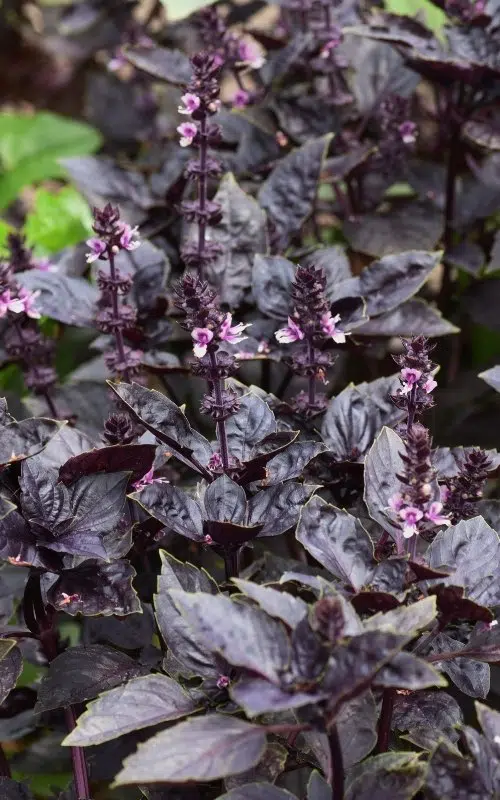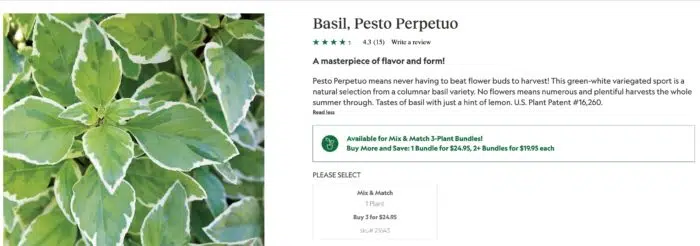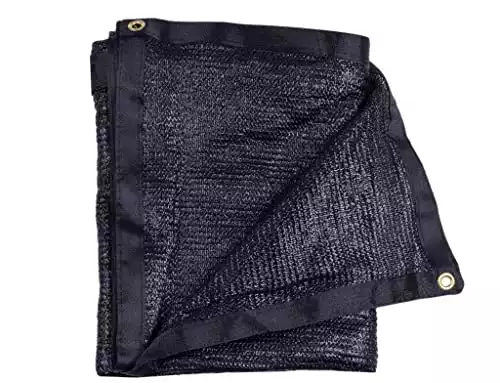When I first saw basil flowers on my plant, I was completely perplexed. This is basil, it should just grow delicious basil leaves for me to eat!
I started searching the internet for what to do next, because, well I want more leaves, not basil flowers.
Turns out there is an easy way to stop the basil flowering process, but you can’t avoid it forever. Eventually, the basil will flower and pass over the rainbow bridge.
What Does it Mean When Basil Plants Flower?
While we generally think of herbs and vegetables as something delicious to eat, we often forget that the main function of plants is reproduction. This is where flowering comes in. The basil plant slows its leaf growth in order to put its energy into growing flowers that contain seeds.
All varieties of basil do this- Thai, Italian, sweet, and lemon basil – they all go through this flowering process.
So when you see buds and actual flowers starting to spring up, it means the plant either thinks it’s going to pass soon — maybe a cold few days have gone by, or the length of daylight starts to change.
Does Basil Die After it Flowers?
Yes, but not right away. The flowering process takes quite a bit of time.
Before the plant crosses that rainbow bridge, Mrs. Basil wants to drop some seeds to ensure her breed will stay around after she’s gone. Flowers hold on to the seed and eventually spread them out along the ground in your garden with the help of the wind.
But you can delay this process and keep your basil plant providing you with delicious leaves for a longer time.
Is Basil Still Good to Eat After it Flowers?
This question is simple, but complex at the same time.
While you can still eat the leaves off your basil plant after it flowers, the leaves generally start changing flavor and turn bitter once the flowers arrive and the bolting process begins. Bolting is when a plant becomes unusable and is generally used for seed.
If you have a lot of already bloomed flowers, the leaves will likely have a bitter, almost licorice flavor that is hard for most to eat.
So, what should you do when you start to see flowers? Pinch those babies off!

Should You Pinch Basil Flowers?
Pruning your basil plants regularly will keep the plant strong and healthy so it can produce more edible leaves for you.
Basil puts off beautiful purple or white flowers depending on which type of basil you’re growing. When you start to see flowers, it means the plant feels it’s time to die and it starts to “go to seed”. You can stop this process by pinching off the flowers.
When you “pinch” basil flowers, you’re essentially removing them in a way that will allow the basil plant to get back to focusing on generating more leaves, instead of growing flower buds.
Expert advice says it’s best to do this in the morning after the dew has dried but before the sun heats up. This will keep the essential oils in the plant that contain the flavor at their peak.
But if that’s not an option, just pull them off when you’re able to. It’s best to still have a plant that hasn’t bolted than to wait for the perfect time to pinch it’s flowers.
How to Pinch Flowers off Your Basil Plant
This is a pretty straightforward process, but you want to follow a few guidelines to make sure you’re doing it correctly.
1. Locate any visible flower buds on your basil plants
2. Cut (or pinch) that part of the plant right after it splits off the main stem. See below:
3. Keep an eye out for future basil flowers and repeat the process.
Simple, right? As long as you keep your eyes open! 🙂
Basil goes to flower when you’re least expecting it, so make sure you catch the buds before they actually turn into basil flowers. The more flowers you have, generally, the more bitter the leaves become. If there are a lot of flowers, it might be a sign to you want to harvest the plants, save the seed, and grow some more basil.
Can You Eat Basil Flowers?
So, are basil flowers edible? Yes, you can absolutely eat basil flowers.
They often taste like the basil flavor you’re used to, but a little milder. If they have been flowering for a while they might be a little bitter, so it’s best to taste test them before making the following recipes.
What Can You Do With Fresh Basil Flowers?
Once you harvest basil flowers, there are a few ways you can use the them in the kitchen. While I’m generally not the one cooking, these ideas are super simple.
1. Basil Flower Oil
Yes, you can make oil with basil blooms – and it’s delicious! Basil flower oil is essentially your favorite oil (preferably olive) with a hint of basil added from the flowers.
- Wash the flowers well and dry them off
- Put the basil flowers in a mason jar or other glass jar
- Add basil leaves as well to the desired flavor (optional)
- Fill the rest of the jar with olive oil
- Put a lid on top
- Let it marinate for a week or two on the window sill
- Enjoy your basil infused olive oil!
Once you go to use it, you can either strain out the flowers or put some mesh over the top of the jar and strain them out that way. This oil is great for dipping bread, cooking your favorite dishes and more.
2. Basil Flower Vinegar
Making basil flower vinegar is similar to how you make infused oil, but using red or white wine vinegar instead.
- Take some freshly plucked flowers
- Wash them off and pat them down to dry
- Put the flowers in a mason jar (you can leave the stems attached)
- Add basil leaves to add more flavor (optional)
- Fill the rest of the jar with red or white wine vinegar
- Make sure to close the lid tightly
- Let the mixture infuse for at least a week
- Enjoy your basil-infused vinegar
This recipe is great for salad dressings or for dipping bread.
3. Basil Tea
You can even make basil tea with your flowers. Just add them to a cup of almost boiling water and let them steep for a few minutes.
Use a tea strainer or any kitchen strainer you have to remove the particles, and enjoy your tea!
Add lemon for an extra kick of flavor!
4. Add them to Your Pesto
I love this idea since pesto is one of my favorites! You can make basil flower pesto for a slightly bitter but more complex flavor. Just throw the flowers in with some fresh basil leaves and voila! You have an upgraded pesto!
5. Garnish for Salads, Pasta, Pizza
Basil flowers make great additions to all kinds of food. You can add them to salads, or on top of a Margherita (or any) pizza, and throw them on a pasta or other meal you make.
Your friends and family will likely be impressed, as most people don’t realize you can use the flowers of basil plants.
6. Basil Infused Simple Syrup
This one is one of the favorites and is great for alcoholic beverages, ice cream, pretty much anything. It’s super versatile and a great addition to your kitchen or bar at home.
1. Add equal parts of water, sugar and basil leaves and flowers. (i.e. 1 cup water, 1 cup sugar, 1 cup basil leaves/flowers)
2. Place them in a small saucepan and bring the mixture to boil, stirring to make sure the sugar dissolves.
3. Let it simmer for around a minute (it doesn’t take long!) and remove from the heat.
4. Let the syrup rest for about 30 minutes so the basil flavors mesh together well.
5. Once it’s cooled, put the syrup into jar or plastic squirt bottle using a strainer to remove the leaves and flowers, and let it cool.
6. Add a lid, and you now have fresh basil simple syrup at the ready!
Can You Plant Basil Flowers and Seeds?
Great question! Of course you can. Your basil plants created those seeds to continue its family line. 🙂 In all seriousness, that’s what those flower heads are for! To drop seeds and start the growth process all over again.
How to Save Basil Seeds
Once the basil plant flowers, the flowers open and are hopefully pollinated, the stem will dry out and turn brown. The flowering process is pretty much complete at that point.
Take those inside so they don’t blow away (you’ll thank me later). Crack open the flower buds and you’ll start seeing the basil seeds coming out.
You can go ahead and plant those right away, or you can save them for next year’s herb harvest. Make sure you label the container you put them in so you know which herb variety they are.
Keep in mind that bees and other insects in your garden will cross-pollinate varieties of basil (flying from one plant to the next). So, if you’ve planted multiple basil varieties, you may end up with a different variety of basil that that a unique flavor.
How to Prevent Basil From Flowering
There are a few ways you can prevent your basil from flowering in the future.
1. Prune the Terminal Shoots
If you were to let your basil grow and just pull off leaves here and there, it would try to become a tall plant. But we want a more bushy basil plant, right?
With most side stems, you’ll end up with a larger harvest, and you can prevent your basil from trying to put off flowers as much.
The terminal shoot of the plant is what we’d probably consider the “main stem”. Of course, you don’t want to just cut off the whole stem, but you want to prune the plant above the third “layer” of stems.
By regularly pruning the plant’s terminal shoots, you are encouraging it to grow more leaves on the side stems as opposed to flowers. And, at the same time, you’re harvesting some leaves you can use in pesto or other foods.
2. Protect it From Extreme Temperatures
Basil is not a fan of summer’s extremely hot temperatures. The high heat can stress the plant out and cause it to quickly try and produce flowers before it dies.
What can you do?
If you notice unseasonably warm days coming up in the weather forecast, try protecting your plant from the heat on those days.
Shade cloth is a great option for this, because it’s transparent enough to let light through, but will block a good amount of heat, giving your basil plant better conditions on those hot days.
While it might seem like you’re blocking out all of the sunlight, it’s actually going to help the plant and allow enough sunlight in for it to grow.
3. Properly Water Your Basil Plant
Not watering your plant is a common problem when it comes to growing basil, but even more so is overwatering your plants.
More plants die of overwatering than they do of going without water for a few days. And water problems can stress them out enough to get your basil plant flowering in no time.
Make sure you’re properly watering the plants, but not producing too much water either. Check the soil about an inch below the surface with your finger.
If it’s wet, don’t water it and check again tomorrow. If it’s dry, go ahead and water the plant.
Related Post: How Often to Water Basil [& The Best Ways]
4. Grow a Basil Variety That Doesn’t Flower
Yes, it does exist! The Pesto Perpetuo variety of basil is one that doesn’t produce flowers, so if you’ve always struggled with this, you can grow basil that won’t flower.
With a name like Pesto Perpetuo, how can you go wrong?! 🙂
This plant does have a slight lemon flavor but does well as a substitute for sweet basil and other basil varieties.





I want mine to flower but they haven’t. 10 plants and not a single flower. Everyone else has the opposite problem from what I am reading. They are at day 80. Guess I have to be patient.